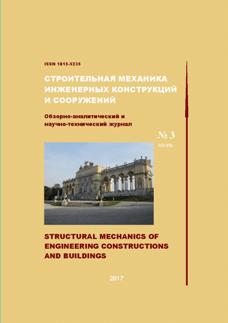ON THE INVESTIGATIONS OF RULED HELICAL SHELLS IN 2000-2017
- Authors: Vladimir J.P.1
-
Affiliations:
- RUDN University
- Issue: No 3 (2017)
- Pages: 9-11
- Section: Articles
- URL: https://journals.rudn.ru/structural-mechanics/article/view/16302
- ID: 16302
Cite item
Full Text
Abstract
Currently, much attention is paid to development of infrastructure, which is associated with an increase in construction volumes and reducing the area of development, as well as introducing new architectural forms in the typical structures of socio economic purpose. The peak of publication on analytical methods of linear analysis of helicoidal shells was in the 1950s. In this work, detailed review of the literature on the topic of the geometry, the static analysis, and the use of ruled helicoidal shells in the 2000-2017 years is presented.
Full Text
In the second half of the twentieth century, a lot of papers on geometry, the static analysis and the application of helicoidal shells including ruled helical shells were published. The most complete review is given in the review manuscript of S.N. Krivoshapko [1] with 181 references. Five types of ruled helical surfaces (Fig. 1) are described in a work [2]. After 2000, only several scientists-mechanics continued to deal with the ruled helicoidal shells, basically they developed analytical and semi-analytical methods of static analysis. For example, stress-strain state of developable helicoids (Fig. 1, c) under the action of uniformly distributed static load was studied in [3]. Thin open developable helicoidal shells are used in mechanical engineering and in civil engineering. The numerical analysis of shell stress-strain state was fulfilled with the help of the Runge-Kutta method. The analytical asymptotic method of analysis is presented for thin elastic open helicoidal shallow shells given in curvilinear non-orthogonal conjugate coordinates. Right helicoids (Fig.1, a) were investigated by M.I. Rynkovskaya [4]. She found some inaccuracies in the method of calculation proposed by V.G. Rekach [5]. Apparently, it is necessary to introduce a subspecies of right helicoids - pre-twisted beams or plates which from a point of view of the geometry are right helicoids with straight generatrix that intersects the helix axis, that is, a straight generatrix exists on either side of the axis. Unlike from right helicoids, pre-twisted beam is still at the center of attention of scientists in mechanics, and the problems of determination of forms and the frequencies of natural oscillations are investigated in a dozen of works [6]. E.M. Tupikova [7] is actively working on finding analytical and numerical methods for the calculation of oblique helicoids (Fig. 1, b). She solved only one- dimensional problems for this type of helicoids. Only one researcher was looking for methods of calculation of the stress-strain state of long pseudo-developable helicoids (Fig. 1, e). He published only two scientific papers on this subject [8]. The straight generatrixes of this surface on plane coincide with the tangents to the helical guideline as well as in the case of the developable helicoid. For the pseudo-developable helicoids of general type offered by S.F. Pilipaka (Fig. 1, d) [9], the author didn’t find data on determination of their stress-strain state by either analytical or numerical method. Although the number of publications devoted to geometry, static calculation and application of ruled helicoidal shells decreased significantly, but their application has not declined, and it is obviously from the scientific paper of A. Bogolyubov [10]. Conclusion After reviewing of the available scientific and technical literature, the author decided to choose the theme for his master's thesis: "Numerical experiments on the selection of a thin ruled helicoidal shell as applied to civil structures" and I hope that the results obtained in the process of the preparation of the thesis will be useful to my homeland, Haiti. Especially because it’s popular, attractive and it conserves space; it’s a new technology which big countries use for their cities to give them good-looking, pretty and it gives many space for people to move along that’s why we say that it’s economic. It’s the best technology for my country because my homeland doesn’t have a big superficies. Below there are some examples in pictures of this technology (Fig. 2, a,b,c). Figure 2. Examples for ruled helicoidal shells shopping center, Miami (USA) business center, New Jersey(USA), Nap Architects, Japan
About the authors
Jean PAUL Vladimir
RUDN University
Author for correspondence.
Email: jeanpaulvladimir@yahoo.fr
BSc
Russian Federation 117198, Moscow, Miklukho-Maklaya street, 6References
- Krivoshapko S.N. (May 1999) Geometry and strength of general helicoidal shells, Applied Mechanics Reviews, Vol. 52, No 5, 161-175.
- Krivoshapko S. N. and Rynkovskaya Marina. Five types of ruled helical surfaces for helical conveyers, support anchors and screws, MATEC Web Conf., 2017, Vol. 95 (2016 the 3rd International Conference on Mechatronics and Mechanical Engineering (ICMME 2016)), 5 p.
- Krivoshapko S.N., Gbaguidi A?ss? Gerard. (2012) Two methods of analysis of thin elastic open helicoidal shells, International Journal of Research and Reviews in Applied Sciences, Vol. 12, Iss. 3, 382-390.
- Rynkovskaya M.I. (2009) On application and analysis of right helicoidal shells. RUDN Journal of Engineering Researches, № 3, 113-116. (In Russ).
- Rynkovskaya M.I. (2008) Rekach’s method of calculation as applied to right helicoid, Structural Mechanics of Engineering Constructions and Buildings, № 3, 23-29. (In Russ).
- Sinan Filiz, Bekir Bediz, L.A. Romero, O.Burak Ozdoganlar. (12 May 2014)Three dimensional dynamics of pretwisted beams: A spectral-Tchebychev solution, Journal of Sound and Vibration, Vol. 333, Iss 10, 2823-2839.
- Tupikova E.M. (2015)The determination of displacements and internal forces in reinforced concrete ramps in the form of oblique helicoid, Stroit. Mech. i Raschet Soor., № 4, 24-28. (In Russ).
- Halabi S.M. (2001) Moment theory of thin helicoidal pseudo-developable shells, Structural Mechanics of Engineering Constructions and Buildings, Iss. 10, 61-67. (In Russ).
- Pylypaka, S.F. (2002). Control of bending of ruled surfaces on an example of a screw conoid, Prikladna Geom. ta Inzhenerna Grafika, Кiev: KNUBA, Vyp. 70, 180-186.
- Bogolyubov A.V. (2012) On impossibility of theoretically exact working of ruled helical surfaces by a round cylindrical tool, Vestnik MGTU “STANKIN”, 2(20), 79-74. (In Russ).
Supplementary files















